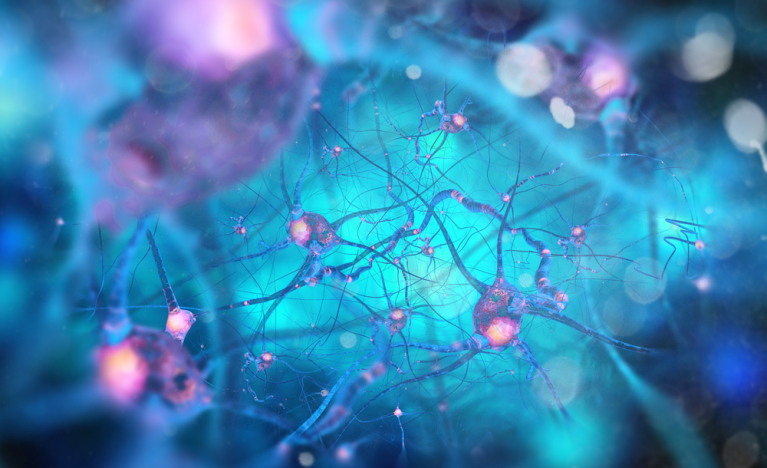Neurons are the cells that serve as building blocks of the nervous system. The brain contains an enormous variety of neurons, and they all need to get a start somewhere. The process by which neurons are formed is called neurogenesis.

When does neurogenesis happen?
Nearly all neurogenesis occurs before the age of 2 when the brain is in the early stages of being formed and refined. While most cells in the body are replaced as they wear out or get injured, neurons in the brain do not. By young adulthood, the brain has largely stopped making new neurons. Other than serving as an excellent reason to wear a helmet and otherwise protect your head from injury, this lack of new neuron formation doesn’t have a noticeable effect on how we go about our daily lives. After all, neurons are an incredibly adaptable cell type that readily change in response to a person’s environment and experiences.
In the past few decades, we have learned that there is an exception to the “all neurons are born early in life” rule. Some research has shown that new neurons can, in fact, be formed during adulthood in specific brain areas. For example, the hippocampus, a brain structure important for its role in forming and maintaining memories, continues to create neurons over the course of one’s life.
The purpose of these newly generated neurons is still debated. However, numerous studies have shown that neuron formation in the hippocampus is reduced in instances of psychiatric and neurodegenerative disorders. This includes certain types of ataxia like SCA1. This is thought to contribute to changes in cognitive function and mood, though the exact mechanisms are still being determined.
Why is neurogenesis interesting for the spinocerebellar ataxias (SCAs), aren’t these neurodegenerative disorders?
Since the discovery of neurodegenerative disorders, most research has focused on symptoms and how to delay symptom onset. This view sees neurodegenerative disorders, like the SCAs, as outcomes of mid to late-life when the toxic effects of mutant proteins become suddenly rampant. However, these disorders are caused by proteins that are present from the very earliest stages of brain formation.
In 2018, researchers studying SCA1 found that neurogenesis is increased in the cerebellum of young mice. This changed how the cerebellum communicates with the rest of the brain. This suggests that cerebellar function can be affected by more than neuronal loss. It could be of wider interest in the SCAs given the cerebellar dysfunction that is common between them. No research on cerebellar neurogenesis has been performed in other SCAs by this point. However, there are some indications that neurogenesis may also be altered in SCA2.
Additionally, Huntington’s Disease, a polyglutamine repeat disorder in the same disease family as several SCAs, has been shown to have increased neurogenesis in the cortex in both young mice and prenatal babies. The combination of these recent studies has made early neuron formation an area of key interest in the study of neurodegenerative disorders.
Current theories in the field contend that while the brain can compensate for changes in neuron numbers in early life, altered neurogenesis could be creating unique brain circuitry in individuals with known disorder-causing protein mutations. These changes could make them more vulnerable to neuronal dysfunction and neurodegeneration later in life.
Evidence for changed neurogenesis in SCAs, both early and late in life, adds a new layer of consideration to what we broadly think of as a mid- to late-life neurodegenerative disease. Additional research in coming years will hopefully provide more insight into how these additional facets of neural health may inform the development of new therapies.
If you would like to learn more about neurogenesis, take a look at these resources by the Queensland Brain Insitute and News-Medical.
Snapshot written by Carrie Sheeler and edited by Dr. Chloe Soutar.
Additional References
Cvetanovic M, Hu YS, Opal P. Mutant Ataxin-1 Inhibits Neural Progenitor Cell Proliferation in SCA1. Cerebellum. 2017 Apr;16(2):340-347. doi: 10.1007/s12311-016-0794-9. PMID: 27306906; PMCID: PMC5510931.
Shukla JP, Deshpande G, Shashidhara LS. Ataxin 2-binding protein 1 is a context-specific positive regulator of Notch signaling during neurogenesis in Drosophila melanogaster. Development. 2017 Mar 1;144(5):905-915. doi: 10.1242/dev.140657. Epub 2017 Feb 7. PMID: 28174239; PMCID: PMC5374347.
Xia G, Santostefano K, Hamazaki T, Liu J, Subramony SH, Terada N, Ashizawa T. Generation of human-induced pluripotent stem cells to model spinocerebellar ataxia type 2 in vitro. J Mol Neurosci. 2013 Oct;51(2):237-48. doi: 10.1007/s12031-012-9930-2. Epub 2012 Dec 9. PMID: 23224816; PMCID: PMC3608734.
Barnat M, Capizzi M, Aparicio E, Boluda S, Wennagel D, Kacher R, Kassem R, Lenoir S, Agasse F, Braz BY, Liu JP, Ighil J, Tessier A, Zeitlin SO, Duyckaerts C, Dommergues M, Durr A, Humbert S. Huntington’s disease alters human neurodevelopment. Science. 2020 Aug 14;369(6505):787-793. doi: 10.1126/science.aax3338. Epub 2020 Jul 16. PMID: 32675289; PMCID: PMC7859879.










